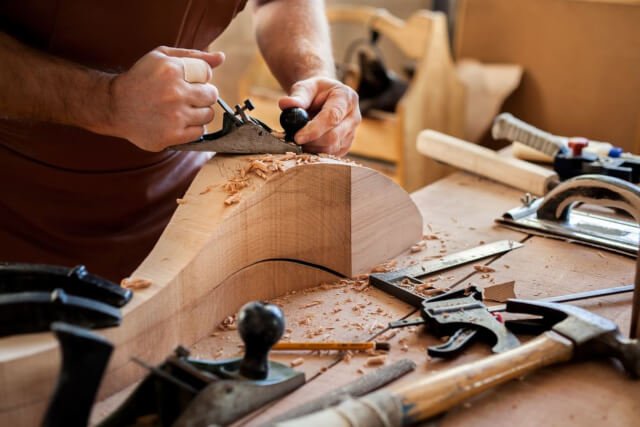Woodworking chisels are essential tools for any woodworker, allowing them to create intricate designs, carve details, and shape wood with precision. This guide to chisels for woodworking tools for working wood will provide valuable insights into this versatile tool that is a staple in every woodshop.
When it comes to woodworking chisels, there are a variety of types available, each serving a specific purpose. From bench chisels to mortise chisels and carving gouges, understanding the different options and their uses can significantly enhance your woodworking projects. Choosing the right chisel for the job is crucial for achieving professional results and mastering the art of woodworking.
In addition to exploring the various types of woodworking chisels, this guide will also delve into key factors to consider when selecting the best chisel for your needs. Factors such as blade materials, handle options, and care techniques can make a significant difference in the quality of your work and the longevity of your tools. By understanding these essential aspects, you can elevate your woodworking skills and create masterful pieces with confidence.
Types of Woodworking Chisels
Woodworking chisels come in various types, each designed for specific tasks in woodworking projects. Understanding the different types of chisels available can significantly enhance your woodworking experience and the quality of your finished products.
One common type is the bench chisel, which is versatile and suitable for a wide range of woodworking tasks such as paring, chopping, and slicing. Mortise chisels, on the other hand, are specifically designed for creating mortises, making them ideal for joinery work. Additionally, bevel edge chisels have a beveled edge that allows for precision when working on tight corners and angles.
Another important type is the skew chisel, which features a skewed blade that excels in detail work and shaping concave surfaces. Carving chisels are specialized tools used for intricate carving work and decorative detailing in woodwork projects. With a variety of chisel types available, it is essential to choose the right one based on the specific tasks you will be undertaking.
When selecting woodworking chisels for your projects, consider factors such as the type of wood you will be working with, the level of precision required, and the overall design of your project. Investing in high-quality chisels made from durable materials will ensure longevity and performance in your woodworking endeavors. Remember to choose chisels that feel comfortable in your hand to prevent fatigue during extended use.
| Types of Chisels | Overview |
|---|---|
| Bench Chisel | Versatile tool suitable for various tasks such as paring, chopping, and slicing. |
| Mortise Chisel | Specifically designed for creating mortises, ideal for joinery work. |
| Bevel Edge Chisel | Features a beveled edge for precision cutting on tight corners and angles. |
Key Factors to Consider When Choosing Chisels for Woodworking
Woodworking chisels are essential tools for any woodworker, providing precision and control when shaping and carving wood. When choosing the right chisel for your woodworking projects, there are several key factors to consider to ensure you have the best tool for the job. One of the most important factors to consider is the type of wood you will be working with. Different woods require different types of chisels due to their hardness and grain patterns.
Another crucial factor to consider when choosing chisels for woodworking is the size and shape of the blade. The width of the blade will determine the amount of material you can remove at once, while the shape of the blade will determine the type of cuts you can make. For example, a straight-edged blade is ideal for making flat and straight cuts, while a skew-edged blade is better suited for making angled or curved cuts.
Lastly, it is important to consider your budget when selecting woodworking chisels. While high-quality chisels made from premium materials may come at a higher cost, they often provide better performance and durability in the long run. However, there are also affordable options available that can still offer decent quality for beginners or hobbyists looking to start their woodworking journey without breaking the bank.
| Factors to Consider | Importance |
|---|---|
| Wood Type | Determines which type of chisel is suitable |
| Blade Size and Shape | Affects cutting capabilities |
| Budget | Determines quality and affordability |
Understanding Blade Materials
When it comes to woodworking chisels, the blade material plays a crucial role in determining the tool’s performance and durability. There are several common blade materials used in chisels, each with its unique characteristics and benefits. Understanding these materials can help you make an informed decision when choosing chisels for your woodworking projects.
High Carbon Steel Blades
High carbon steel blades are known for their excellent edge retention and ease of sharpening. These blades are often preferred by woodworkers who value sharpness above all else. However, high carbon steel blades are prone to rust if not properly cared for, so it is essential to keep them clean and dry after use. These blades are suitable for delicate tasks that require precise cuts.
Cr-Mn Steel Blades
Chisels with chrome-manganese (Cr-Mn) steel blades offer a good balance between edge retention and rust resistance. Cr-Mn steel is more durable than high carbon steel and less prone to corrosion, making it a versatile option for various woodworking projects. These blades are ideal for both rough cutting and fine detailing work, making them a popular choice among woodworkers of all skill levels.
Tungsten Carbide Blades
Tungsten carbide blades are incredibly hard and long-lasting, making them ideal for heavy-duty applications such as working with hardwoods or abrasive materials. While tungsten carbide blades are more expensive than other options, their exceptional durability makes them a worthwhile investment for serious woodworkers. These blades require specialized sharpening equipment due to their hardness but offer unmatched longevity and performance in the long run.
By considering the characteristics of different blade materials, you can choose the best chisels for your specific woodworking needs. Whether you prioritize sharpness, durability, or versatility, selecting the right blade material can make a significant difference in your woodworking projects’ outcome. Experimenting with different types of chisels can also help you determine which blade material works best for your preferred woodworking techniques and style.
Handle Options for Woodworking Chisels
Woodworking chisels are essential tools for any woodworker, allowing for precise shaping, trimming, and carving of wood. When it comes to choosing the right woodworking chisel, one important factor to consider is the handle design. The handle of a chisel plays a crucial role in providing comfort and control during use. There are various handle options available, each offering unique benefits for different woodworking tasks.
To help you navigate the world of woodworking chisels and find the best handle option for your needs, here is a breakdown of some common handle designs:
- Wooden Handles: Traditional and aesthetically pleasing, wooden handles offer a natural feel and warmth in hand. They can be customized by shaping or sanding to fit your grip comfortably.
- Plastic Handles: Lightweight and durable, plastic handles are easy to clean and maintain. They are often ergonomically designed with textured grips for better control.
- Rubber Handles: Designed for increased comfort and reduced hand fatigue, rubber handles provide excellent shock absorption. They are ideal for prolonged use on demanding woodworking projects.
When selecting a woodworking chisel based on its handle design, consider factors such as the size of your hands, the type of woodworking tasks you will be performing, and personal preferences for grip texture and material. Ultimately, choosing a chisel with a comfortable and ergonomic handle will enhance your overall woodworking experience by allowing you to work more efficiently and accurately.
Properly maintaining the handle of your woodworking chisels is also important to ensure their longevity. Regular cleaning and conditioning can help prevent cracks or splinters in wooden handles, while checking for any signs of wear or damage in plastic or rubber handles is equally crucial. By selecting the right handle option and caring for it properly, you can enjoy using your chisels for many woodworking projects to come.
Care and Maintenance Tips for Keeping Your Chisels Sharp
Woodworking chisels are essential tools for any woodworker looking to create precise and intricate designs in their projects. To ensure that your chisels remain sharp and provide accurate cuts, proper care and maintenance are crucial. Here are some tips on how to keep your chisels in top condition for optimal performance:
- Regular Sharpening: Keeping your chisels sharp is essential for clean and precise cuts. Invest in high-quality sharpening stones or sharpening systems to maintain a keen edge on your chisels.
- Proper Storage: Store your chisels in a designated case or rack to prevent damage to the cutting edge. Avoid tossing them into a toolbox where they can knock against other tools and lose their sharpness.
- Protective Measures: While working with chisels, use a protective cap or sheath to cover the cutting edge when not in use. This will prevent accidental nicks or dulling of the blade.
Additionally, incorporating honing guides into your sharpening routine can help maintain consistent bevel angles on your chisels, ensuring uniformity in your cuts. These guides are especially helpful for beginners who may struggle with freehand sharpening techniques. With proper care and maintenance, your woodworking chisels will continue to be reliable tools in your workshop for years to come.
Remember that each type of wood requires different levels of sharpness on the blade – from softwoods like pine to hardwoods like oak, adjust the sharpness accordingly based on the task at hand. By following these care and maintenance tips, you can prolong the lifespan of your chisels and achieve professional results in all your woodworking projects.
Essential Accessories for Chisels
Sharpening Stones: The Key to a Sharp Edge
One of the most important accessories for chisels in woodworking is sharpening stones. Keeping your chisels sharp is crucial for achieving clean cuts and precise shaping in your woodworking projects. There are various types of sharpening stones available, such as water stones, oil stones, and diamond stones. Each type has its own advantages and best practices for sharpening chisels effectively.
When using sharpening stones, it is essential to learn the proper technique to ensure that you maintain the correct angle while sharpening. Additionally, regularly flattening your sharpening stone surface is necessary to prevent uneven wearing and maintain consistent sharpening results. Investing in high-quality sharpening stones will not only prolong the life of your chisels but also improve the overall quality of your work.
Honing Guides: Ensuring Precision and Consistency
Another accessory that plays a key role in maintaining sharp chisels is honing guides. Honing guides help woodworkers achieve consistent bevel angles when sharpening their chisels. By using a honing guide, you can ensure that each chisel blade is honed to the same angle, leading to uniform cutting edges across all your tools.
Honing guides are particularly beneficial for beginners or woodworkers who may struggle with maintaining a consistent angle while sharpening freehand. They provide stability and control, resulting in sharper chisels that produce cleaner cuts in your woodworking projects. When paired with quality sharpening stones, honing guides can significantly improve the sharpness and precision of your chisels.
Additional Accessories: Strop Blocks, Angle Gauges, and More
In addition to sharpening stones and honing guides, there are other accessories that can further enhance your woodworking experience with chisels. Strop blocks are useful for polishing and refining the cutting edge of your chisel after sharpening.
Angle gauges help you set precise angles when honing or sharpening your chisels for different tasks. Whether you’re a novice or experienced woodworker, having the right accessories can make a significant difference in the performance of your chisels and the quality of your woodworking projects.
Expert Tips and Techniques for Using Chisels in Woodworking Projects
When it comes to using chisels in woodworking projects, there are several tips and techniques that can help you achieve the best results. One important tip is to always make sure your chisel is sharp before starting any project. A dull chisel not only makes the work harder but also increases the risk of accidents. Invest in high-quality sharpening stones and honing guides to keep your chisels razor-sharp.
Another essential technique when using chisels is to work with the grain of the wood. By following the natural direction of the wood fibers, you can prevent tear-out and achieve a smoother finish. Additionally, using light pressure and making multiple shallow cuts instead of one deep cut can help you maintain better control over your chisel and avoid splintering the wood.
It’s also important to have a good grip on your chisel while working. Make sure your chisel handle fits comfortably in your hand and provides good support for precise cuts. Experiment with different grip techniques to find what works best for you and allows you to have maximum control over the tool. With practice and patience, mastering these expert tips and techniques will help you elevate your woodworking projects to a professional level.
Conclusion
In conclusion, mastering the art of chiseling in woodworking requires a deep understanding of the different types of chisels available and their respective uses. By familiarizing yourself with the key factors to consider when choosing chisels, such as blade materials and handle options, you can ensure that you have the right tool for any project.
Additionally, investing time in proper care and maintenance, including sharpening techniques using sharpening stones and honing guides, will prolong the life of your chisels and keep them performing at their best.
Furthermore, expert tips and techniques can elevate your woodworking projects to new levels. Whether it’s learning how to make precise cuts or creating intricate designs, honing your skills with chisels can open up a world of possibilities in woodworking. Remember that practice makes perfect, so don’t be afraid to experiment and push yourself creatively with different chisel techniques.
Overall, having a solid grasp on the fundamentals of using chisels in woodworking will empower you to take on a wide range of projects with confidence and precision. With this guide to chisels for woodworking tools for working wood as your companion, you’ll be well-equipped to tackle any task that comes your way in the workshop. So go ahead, unleash your creativity, and let your craftsmanship shine through the careful art of chiseling in woodworking.
Frequently Asked Questions
How Do I Choose Wood Chisels?
When choosing wood chisels for your woodworking projects, it is important to consider the type of work you will be doing. Factors such as blade width, handle material, and overall quality are key considerations.
Look for chisels that have high-quality steel blades that can hold a sharp edge, comfortable handles that allow for good control, and a variety of sizes to suit different tasks.
What Kind of Chisel Do You Use for Woodworking?
In woodworking, the kind of chisel you use depends on the specific task at hand. For general woodworking tasks like shaping or carving wood, beveled edge bench chisels are commonly used due to their versatility. However, specialized chisels like mortise chisels or dovetail chisels are designed for more specific tasks such as cutting joints or creating detailed joinery.
What Is the Best Chisel Set for Woodworking?
The best chisel set for woodworking will ultimately depend on your individual needs and preferences. High-quality sets typically include a variety of chisels in different sizes and types to cater to various woodworking tasks.
Look for sets with durable blades made from high-carbon steel or chrome vanadium steel, ergonomic handles for comfort during extended use, and a storage case to keep them organized and protected when not in use. Consider investing in a reputable brand known for producing reliable tools that withstand the test of time.

Hi everyone! I’m a woodworker and blogger, and this is my woodworking blog. In my blog, I share tips and tricks for woodworkers of all skill levels, as well as project ideas that you can try yourself.





